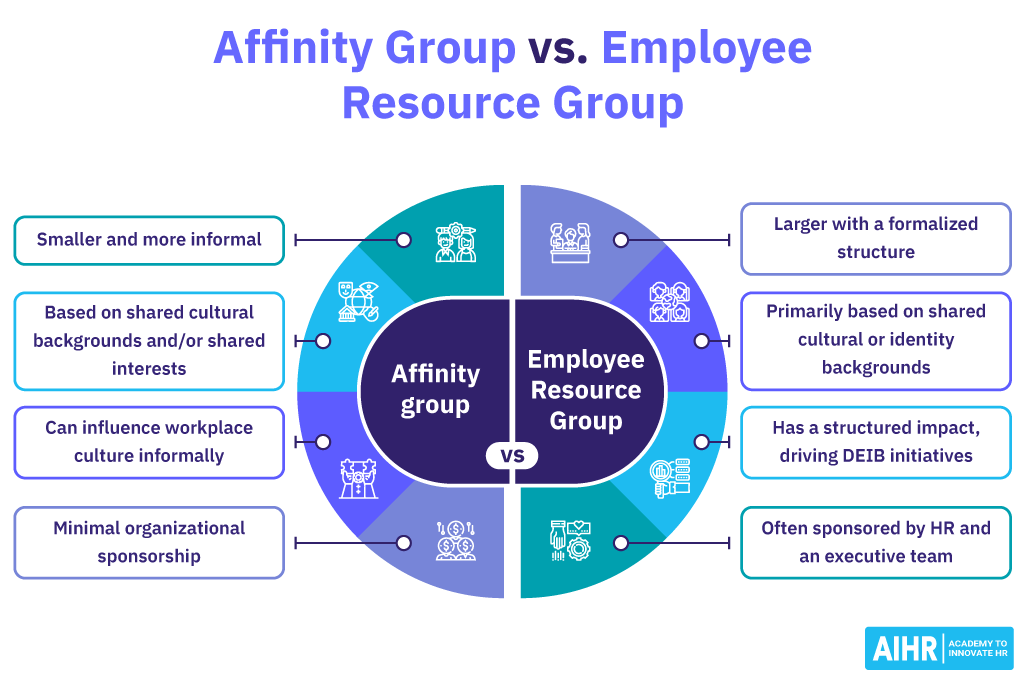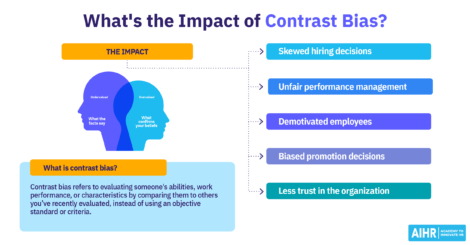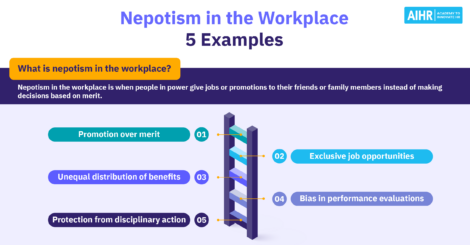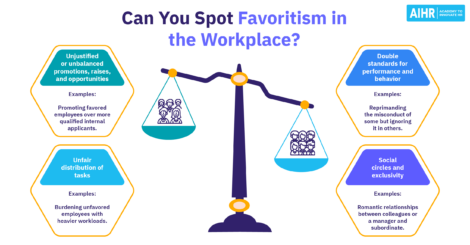Affinity Group vs Employee Resource Group: 12 Main Differences
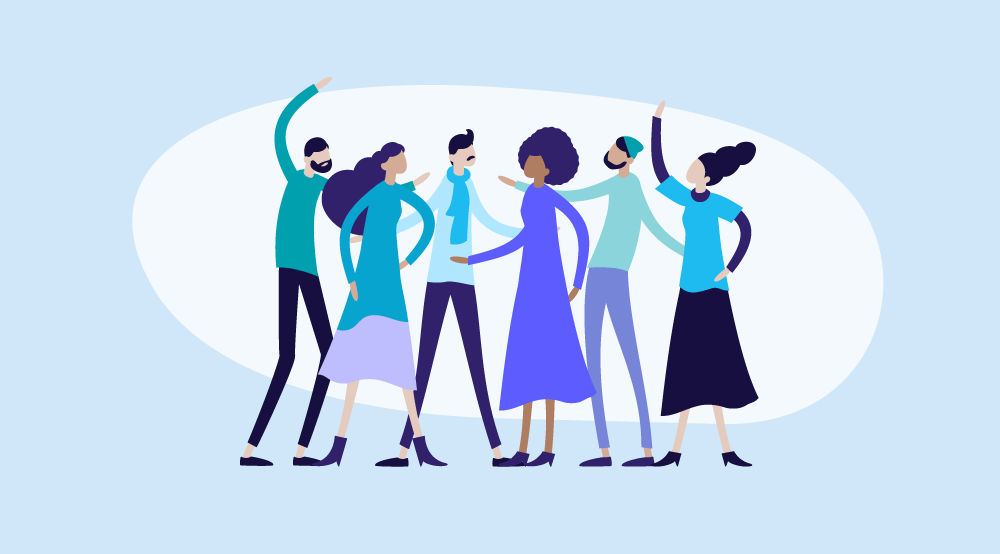
Link the term “employee-led groups” with Diversity, Equity, Inclusion, and Belonging (DEIB), and one of two terms come to mind: affinity groups or employee resource groups.
If you thought AGs and ERGs were “two sides of the same coin,” you would be right, according to global HR resource providers like Gartner and financial enterprises like Peoplejoy. Both companies, as well as countless others, identify ERGs and AGs as interchangeable. But a closer look at their structure, purpose, and history shows clear distinctions and connections between them.
Contents
What is an affinity group?
What is an employee resource group?
12 differences between affinity groups and employee resource groups
How to effectively manage affinity groups and employee resource groups in the workplace
What’s ahead for employee groups?
What is an affinity group?
By most definitions, an affinity group (AG) is an informal, voluntary, diverse employee-led team without direct ties to an employer’s DEIB agenda. Their members may have shared backgrounds based on race, gender, age, physical disability, or sexual orientation, or they may have common interests, like art or mountain climbing.
Affinity groups aren’t limited to the workplace, says 20-year HR veteran Lakia Elam, founder of the HR firm Magnificent Differences Consulting. “Affinity groups can be about anything, from gaming to fitness, or even where people went to college. In this way, AGs are meant to build relationships and culture through shared interests outside the workplace,” Elam explains.
Kraig Kleeman, founder and CEO of The New Workforce, notes that AGs are like clubs for hobbies or interests. “Think of them as the workplace’s unofficial fan clubs. They’re all about letting employees connect over things they’re passionate about, even if it has nothing to do with their day job.”
ERGs shouldn’t be confused with AGs, according to TI Verbatim (TIVC), a DEIB-focused organization. In fact, the Virginia-based company refers to these groups as platforms for mostly socializing and airing grievances with no formal process for measuring their impact on inclusion.
PricewaterhouseCoopers (PwC), a professional services firm, also recognizes the differences between AGs and ERGs. Rather than substitute one name for the other, the company oversees these two employee groups and a third that it calls “networking circles.” It lists all three under the heading “inclusion networks.”
The US General Services Administration (GSA) uses only AGs, not ERGs, to describe its seven employee inclusion groups, four of which include “parents,” “aging parents,” “neurodiversity,” and “self-care.”
Affinity groups benefits and drawbacks
If affinity groups operate with little direction from HR and independently of companies, how can they benefit the workforce? Employees with common interests meet up outside of work anyway, so what can affinity groups give them that they can’t get on their own?
According to the HR consultant Lakia Elam, the answer is greater visibility in the workplace. “Affinity groups offer a few benefits that wouldn’t be possible for individuals,” says Elam. She points out three benefits that AGs create for employees:
- A stronger voice in advocating for organizational change
- More visibility in the workplace
- More opportunities for professional growth.
A specialist in DEIB, hiring, and culture-building, Elam, adds that AGs can make other organizational changes that usually are beyond the reach of individual employees, such as creating funding sources for company events or even getting the employer’s okay to schedule group meetings during work hours.
As for drawbacks, affinity groups’ lack of informal structure and detachment from HR’s oversight may suit some employees while alienating others. Sarah Jeffries, managing director of First Aid Course (UK), argues that employees whose interests aren’t in sync with the group’s purpose may feel isolated.
What is an employee resource group?
Employee resource groups (ERGs) are voluntary, employee-led, company-sponsored teams. Unlike affinity groups, ERGs are structured with direct ties to business DEIB goals and employment practices in general.
As with affinity groups, ERG members have shared cultural and social identities but with less focus, if any, on personal interests.
ERGs represent employees across multiple DEIB-inspired categories. Case in point, aerospace and defense contractor Raytheon Technologies Corporation has nine ERGs, one for each of the following employee sectors:
- Indigenous communities
- Black employees across the African diaspora
- Disabled employees and their allies
- Asians and Pacific Islanders
- Hispanic and Latino communities
- GenX employees
- The LGBTQ+ community
- Armed services personnel, their families, and veterans
- Women’s success and empowerment.
Employee resource groups benefits and drawbacks
Talent recruitment and retention are major ERG advantages in creating an inclusive work environment.
Kraig Kleeman, who is also an author of The Must-React System and A Winning Brand, agrees. He calls ERGs “cool” because they not only tend to attract and keep a more diverse workforce but they also:
- Bring diverse employee perspectives, making workplace decisions more inclusive
- Offer workers opportunities for personal growth, mentorship, and career advancement.
Lakia Elam credits both ERGs and AGs for creating a sense of community and belonging among employees, with the workforce becoming more engaged and productive as a result.
For underrepresented or marginalized employees, ERGs can help make training and development, career advancement, performance recognition, and compensation more equitable and, therefore, more attainable.
But with benefits come drawbacks. ERG’s shortfalls include leaving employees feeling left out when programs are mismanaged and draining HR departments of resources when managing too many groups, says Kleeman.
12 differences between affinity groups and employee resource groups
As an HR professional, you’re more likely to oversee ERGs than anyone else in your organization, according to a Salesforce study. For that reason alone, it pays to understand the commonalities and differences between ERGs and affinity groups.
Sarah Jeffries says, “HR must manage these groups with precision, aligning them flawlessly to the organization’s diversity and inclusion goals while circumventing potential pitfalls.”
“By recognizing the unique advantages and challenges that both groups present, HR professionals can foster an environment where all employees not only feel valued but also become more engaged,” Jeffries concludes.
Lakia Elam adds that knowing the difference between AGs and ERGs makes HR better at managing and allocating resources to the groups.
Employee resource groups evolved from affinity groups
Affinity groups were protest forums for African Americans during the 1960’s Civil Rights movement.
At the time, Xerox CEO Joseph Wilson saw AGs as platforms for calming racial tensions in Rochester, NY, the company’s headquarters. In 1970, Xerox set up the first known company-sponsored ERG based on the 1960s AG model. The Xerox National Black Caucus became an advocacy group for fairness and inclusion in the company.
Organizing for Power, Organizing for Change, a political activist organization, dates affinity groups back even farther than the 60s. During the 1936 Spanish Civil War, comrades formed AGs that met in cafes to discuss ideas and action plans.
Today, 90 percent of Fortune 500 companies have ERGs, according to Pew Research Center survey results. As ERGs morphed into AGs, their differences became less clear.
Let’s summarize the differences and similarities between affinity groups vs employee resource groups.
Affinity groups Employee resource groups Definition An informal, voluntary, diverse employee-led team without direct ties to an employer’s DEIB agenda Structured groups with direct ties to business DEIB goals and employment practices in general. Origin Emerged during social movements like the 1960s Civil Rights movement. Evolved from affinity groups with sponsorship from HR and executives. Organizational sponsorship Generally lack formal organizational sponsorship. Often sponsored by Human Resources and an executive team. Purpose Mostly social or interest-based connections. Business-oriented with aims like improving hiring and retention strategies and building an inclusive workplace. Membership Based on shared cultural backgrounds and/or shared interests (hobbies, activities, etc.) Primarily based on shared cultural or identity backgrounds. Accountability Less structured, not held accountable to organizational objectives. Held accountable to organizational objectives and often have formalized goals. Impact on the workplace Can influence workplace culture informally. Have a structured impact, driving DEIB initiatives. Size and scope Often smaller and more informal. May operate locally or within specific departments. Typically larger and more formal. May have a broader, organization-wide scope. Structure Leadership is often fluid and informal. The structure is usually less hierarchical. Usually have a more formal leadership structure, with designated roles and a clear hierarchy. Funding and resources Generally operate with minimal or no budget. Rely on volunteer efforts and member contributions. Often receive funding and resources from the organization, including budgets for activities and events. Visibility and recognition May have limited visibility within the broader organization. Usually have higher visibility and are recognized as part of the organization’s DEIB efforts. Access to senior leadership Typically have less direct access to senior leadership. Often have direct lines of communication with senior leadership, providing them with a platform to influence decision-making.
How to effectively manage affinity groups and employee resource groups in the workplace
Here’s a 7-point plan for managing employee groups within your organization:
1. Establish the group’s purpose
An employee group needs a clear-cut reason for existing. For instance, should it reduce workplace stress, help veterans transition into civilian jobs, or attract more candidates with disabilities? Define the purpose and expected outcomes of the affinity or employee resource group to ensure alignment with organizational objectives.
2. Set specific goals and objectives
Do you want to increase the number of ERG allies by 25 percent, raise the number of Black managers by 11 percent, or create two more work-life balance options for parents? Goals and objectives make everyone involved with employee groups accountable.
3. Know your target audiences
Consider who the groups are for. Are they focused on specific demographics like GenXers, trans individuals, or indigenous communities, or are they based on shared interests like hobbies or social causes?
Make sure not to let your own biases keep you from offering and supporting employee groups that could bolster your DEIB efforts.
4. Encourage collaboration across groups
Foster collaboration with other groups and departments within the organization to broaden the impact, and reach share resources, and create a culture of inclusivity and teamwork.
Consider organizing joint initiatives, hosting cross-group meetings, and encouraging shared projects that align with the diverse objectives and interests of different employee groups.
5. Provide necessary resources
Provide your affinity groups and ERGs with the funding, tools, and meeting spaces they need to achieve their goals.
For example, ERGs might require a budget for specific DEIB initiatives, while affinity groups may need resources for organizing events or activities.
Kraig Kleeman also advises checking in with employee groups regularly and dealing with problems as they occur.
HR must be ready to sort out any issues without showing favoritism to any group. You don’t want any one group feeling left out or treated unfairly, especially about HR.
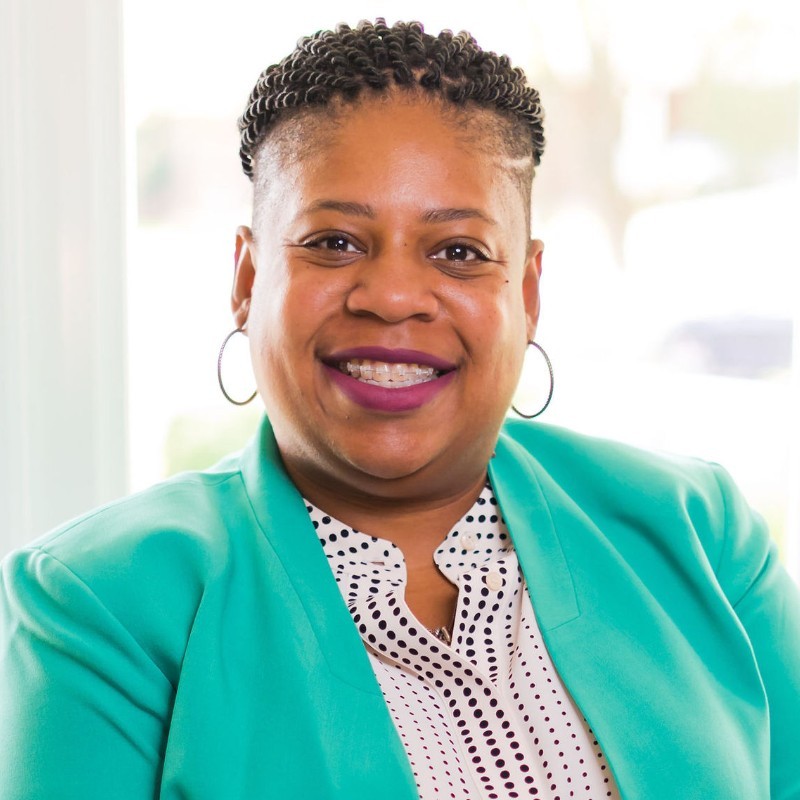
6. Spread the word about the employee groups
Use emails, internal chats, memos, videos, and other platforms to inform employees about your affinity groups and ERGs and their activities. Keep your employees aware of the opportunities for engagement and support.
Additionally, showcasing your employee groups on your career pages helps communicate your organization’s commitment to DEIB to potential candidates who value such initiatives.
7. Evaluate group effectiveness
According to Kraig Kleeman, you’ll know how well your ERGs are doing by the number of employees participating, how long they’re staying around, and what they’re saying through engagement surveys.
For instance, you can gauge participation rates by counting the number of active attendants and dividing it by the number of employees in your organization.
You also can test your ERG’s effectiveness by finding out how the following employment issues are affecting your organization’s demographics (gender, race, ethnicity, disability, LGBTQ+ participation, etc.):
- Retention rates
- Voluntary departures
- Adverse impact
- Candidate diversity
- Promotions
- Pay raises
- Pay equity.
Elam cited employee engagement, retention, promotion rates, the number of initiatives proposed and implemented, and diversity rates as the most important metrics to track.
What’s ahead for employee groups?
Many employers are already phasing out the terms ERGs or AGs and rebranding them as business resource groups (BRGs).
In one example, Capital One merged its DEIB plans and environmental, social, and governance (ESG) program into a BRG.
Deloitte, a global business consulting enterprise, is reframing the meaning of inclusion by bringing all workers – including straight, nonminority men – into employee groups under the umbrella term “inclusion councils.”
The emphasis on “business” in renaming ERGs could soon make traditional affinity groups – with their lack of organizational ties and unstructured formats – obsolete.
Key takeaways
Affinity groups and employee resource groups are not exactly the same. While they are both voluntary, employee-led groups, they differ in their purpose, scope, impact, and other characteristics.
With a clear understanding of the differences between affinity groups and employee resource groups, you can select the group that uplifts your employees, supports your business goals, and helps you decide where to funnel your resources.
Weekly update
Stay up-to-date with the latest news, trends, and resources in HR
Learn more
Related articles
Are you ready for the future of HR?
Learn modern and relevant HR skills, online





